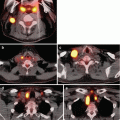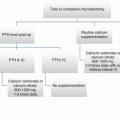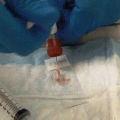Fig. 1.1
Based on SEER data, the number of new cases of thyroid cancer was 13.5 per 100,000 men and women per year. The number of deaths was 0.5 per 100,000 men and women per year. These rates are age adjusted and based on 2008–2012 cases and deaths [5]
The greatest rise in thyroid cancer incidence has been seen in women [12]. Women represent close to 75 % of all thyroid cancer cases and the incidence has risen in both men and women but at a greater rate in women. From 1980 to 1983 versus 2003 to 2005, papillary thyroid cancer rates tripled among white and black females and doubled among white and black males [12]. Although two-thirds of thyroid cancers occur in patients < age 55, the fastest rise in incidence has been seen in adults over age 65 [13, 14]. Older adults have the highest incidence of thyroid cancer per 100,000, with 25.84 new cases diagnosed in patients ages 65–74 years versus 15.16 diagnosed in patients ages 20–49 [5]. Adults aged ≥ 65 also have the greatest growth in incidence with an annual percentage change of 8.8 % versus 6.4 % for those aged < 65 years [5, 15]. The rise in incidence has been seen across race groups, but incidence rates tend to be higher among whites than blacks and among white non-Hispanics than white Hispanics and Asian Pacific Islanders [12]. Historically, thyroid cancer diagnosis has been more common in cohorts with higher socioeconomic status (SES). Based on Surveillance, Epidemiology and End Results (SEER) data from 497 counties in the United States, county papillary thyroid cancer incidence positively correlates with rates of college education, white-collar employment, and family income [15].
The Origin of Thyroid Cancer
Diagnosing thyroid cancer usually starts with identifying a thyroid nodule and/or occasionally lateral neck mass. Between 20 and 70 % of adults have thyroid nodules with older adults having a higher prevalence than younger [16, 17]. In patients with thyroid nodules, male gender, younger age, and high-risk ultrasound characteristics, such as irregular borders, solid, hypoechoic, larger size, and microcalcifications, are associated with greater likelihood of thyroid cancer [18–21].
The majority of thyroid cancers are identified with fine-needle aspiration of a thyroid nodule. Of the nodules that undergo fine needle aspiration (FNA), only 5–8 % are thyroid cancer [22–24]. Although most cancers are diagnosed by FNA, 6–21% of the thyroid operations planned for treatment of benign disease have incidental discovery of thyroid cancer postoperatively [25–27].
The most common thyroid cancer diagnosed is papillary thyroid cancer, which represents 85 % of all thyroid cancers [28]. Additional thyroid cancers include other well-differentiated cancers, such as follicular and Hürthle cell which represent approximately 10 and 3 % of thyroid cancers, respectively [28]. Medullary thyroid cancer arises from c-cells and accounts for less than 5 % of all thyroid cancers [28–30]. Anaplastic is rare and deadly and represents only 1 % of all thyroid cancers [31, 32].
Risk Factors for Thyroid Cancer
As shown in Table 1.1, there are two accepted risk factors for well-differentiated thyroid cancer: ionizing radiation and family history. Ionizing radiation is thought to cause cancer through somatic mutations and DNA strand breaks [14, 33]. When catastrophic events such as Chernobyl happen, the risk of thyroid cancer is dose and age related [34]. Children and young adults under age 20 years are most susceptible to radiation-induced thyroid cancers [14, 35, 36]. Similarly, children who underwent radiation therapy for childhood cancers, acne, treatment of enlarged thymus, etc. also have an increased risk for thyroid cancer [37]. In addition, to radiation exposure, familial nonmedullary thyroid cancer does exist. If two or more first-degree relatives have well-differentiated thyroid cancer, then it is presumed to be hereditary. However, this hereditary form of well-differentiated thyroid cancer cannot be tracked with genetic testing and is thought to represent just over 5 % of all well-differentiated thyroid cancers [38–41]. Recently, a germline variant in HABP2 was identified in familial nonmedullary thyroid cancer [41]. Therefore, for the majority of patients with well-differentiated thyroid cancer, there is no clear etiology of their thyroid cancer and the cancer thought to be sporadic.
Table 1.1
Accepted risk factors for thyroid cancer
Radiation |
Nuclear events such as Chernobyla or Fukushimab |
Treatment of childhood cancers with ionizing (external beam) radiation Treatment of acne, thymus, etc., with ionizing (external beam) radiation Environmental exposures are currently under investigation by several researchers |
Family history |
RET mutations with MEN2A and MEN2B |
Familial nonmedullary thyroid cancers and syndromes |
In comparison, for medullary thyroid cancer, up to 1–7% of patients with apparently sporadic medullary thyroid cancer end up having germline mutations and associated syndromes MEN2A and MEN2B [42, 43]. Genetic testing can identify the RET mutation involved in development of the medullary thyroid cancer, and then subsequent testing can identify family members at risk. In addition to germline mutations, up to half of patients with sporadic medullary thyroid cancer patients have an unidentified somatic RET mutation [44].
There are no clear risk factors for anaplastic thyroid cancer. However, anaplastic thyroid cancer is thought to arise from a well-differentiated thyroid cancer, and it is more common in older adults [32]. There is an accepted “second hit” hypothesis that well-differentiated thyroid cancers typically need a second mutation, often p53, to develop anaplastic thyroid cancer [31].
Proposed Explanations for the Rise in Thyroid Cancer Incidence
Table 1.2 illustrates the two broad theories to explain the rise in thyroid cancer incidence [14]. One theory is that new or previously unidentified risk factors for thyroid cancer explain the rise in incidence. These proposed risk factors would include radiation exposure outside of known catastrophic events or treatment of childhood cancers, obesity/diabetes, autoimmune thyroid disease, and iodine deficiency or excess. Another conflicting theory is that we have detection bias or in essence overdiagnosis leading to the rise in thyroid cancer incidence. In principle, there is a large reservoir of indolent thyroid cancer, and the more we “look,” the more we find. Based on this overdiagnosis theory, increased use of imaging, FNA, surgery, and pathologic inspection leads to detection of cancers that otherwise may have been unidentified. In the following section, we will explain both conflicting theories.
Table 1.2
Proposed explanations for the rise in thyroid cancer incidence
Novel risk factor |
Background environmental radiation |
Obesity/diabetes mellitus |
Autoimmune thyroid disease |
Iodine deficiency or excess Other environmental agents |
Overdiagnosis |
Greater use of neck imaging leading to more nodule detection and cancer diagnosis |
More fine-needle aspirations of nodules leading to more cancer diagnosis |
More surgery leading to more post op incidental cancer discovery |
Greater pathologic inspection leading to more cancer diagnosis |
Explanation 1: New Risk Factor
Exposure to ionizing radiation is an accepted risk factor for well-differentiated thyroid cancer. However, typically patients aged 20 years and younger are most at risk, and in the absence of a recent catastrophic world event, such as Chernobyl or the 2011 reactor meltdown in Fukushima, Japan, this seems like an unlikely explanation for the worldwide rise in thyroid cancer incidence [14, 36]. Although some do worry that the background level of radiation exposure, especially due to increased use of CT scans, has increased and may contribute to the rise in thyroid cancer incidence, it has been estimated that pediatric CT scans account for <1% of the increased incidence of thyroid cancer [14]. Obesity and diabetes mellitus are increasingly common problems in well-developed countries. In parallel to the thyroid cancer epidemic is the obesity and diabetes epidemic [12, 45, 46]. Thus, it has been hypothesized that the thyroid cancer epidemic may be related to the rise in obesity and diabetes mellitus. A pooled analysis of five prospective studies found that obesity is an independent risk factor for thyroid cancer [47]. However, there is more conflicting data when evaluating diabetes and its relationship to thyroid cancer [48, 49]. To-date although correlations between both obesity and diabetes mellitus with thyroid cancer have been noted, causality has not been shown [47, 48].
Autoimmune thyroid disease, specifically Hashimoto’s thyroiditis and Graves’ disease, are common benign thyroid conditions that are similar to the thyroid cancer in the fact that they are far more common in women. There has been longstanding controversy about whether or not autoimmune thyroid disease is associated with thyroid cancer. Surgical studies have suggested a clear association, whereas studies based on FNA samples or antibodies have been less supportive [50–53]. Although thyroid cancer incidence has been rising, there is no clear data that autoimmune thyroid disease is more prevalent now than 30 years ago. Thus, this is an unlikely explanation for the recent rise in thyroid cancer incidence.
Iodine deficiency or excess is known to affect the proportions of thyroid cancer types in the world, as iodine deficiency is associated with a higher proportion of follicular thyroid cancer [54, 55]. However, the relationship between iodine levels and the recent pattern of diagnosing smaller papillary thyroid cancers is unclear [55].
Theory 2: Overdiagnosis
Suggesting that we may be tapping into a reservoir of indolent disease, the greatest rise in incidence has been in low-risk disease. Eighty-seven percent of the increase in thyroid cancer incidence is attributed to papillary thyroid cancers measuring 2 cm or smaller [1]. Since most disease detected is small, the prognosis for most patients is excellent [56]. Mortality for thyroid cancer has consistently been around 0.5 per 100,000 population [5]. Five-year disease-specific survival for localized disease is 99.8%, and for regional disease, it is 97% [2, 9]. Finally, thorough autopsy studies have revealed incidental small thyroid cancers in up to 36% of adults who die from another cause [57]. If pathologic slicing of thyroid specimens were finer, some have suggested that the actual prevalence may be as high as 100% [57]. This implies that there may be a bottomless reservoir of indolent disease. The fact that the rise in thyroid cancer incidence is primarily due to increased detection of low-risk disease and the fact that thyroid cancer is a common incidental finding on autopsy studies support the hypothesis that overdiagnosis may play an important role in the rise of thyroid cancer incidence in developed countries.
Excess thyroid imaging may be one of the reasons for the overdiagnosis of small thyroid cancers. Since at least half of all adults have thyroid nodules, increased imaging can lead to incidental nodule discovery [16, 17, 58, 59]. The rates of detection of thyroid nodules are 67% with thyroid ultrasound (US), 16% with CT and MRI, 9% with carotid duplex, and 3% with positron emission tomography (PET) or PET/CT [59–63]. Over the past 15 years, there has been a rise in the use of imaging studies that are associated with incidental thyroid nodule discovery. Based on data from a large health plan, between 1997 and 2006 use of US increased 40%, use of computed tomography (CT) doubled, and use of magnetic resonance imaging (MRI) tripled [64]. In addition to the rise in use of imaging associated with incidental cancer discovery, thyroid US is increasingly becoming an extension of the physical exam. When there is a palpable nodule, thyroid US is the preferred method of imaging [19]. Neck imaging to evaluate thyroid nodules and symptoms and neck imaging performed for other reasons have contributed to the rise in thyroid cancer incidence [65, 66].
Related to more imaging, greater use of thyroid FNA also leads to more cancer diagnosis. Use of thyroid FNAs more than doubled between 2006 and 2011 [67]. Since approximately 5–8% of thyroid nodules undergoing FNA are cancer and 20% are indeterminate, more FNAs will result in more cancer diagnoses [22–24].
More surgery may also play a role in the thyroid cancer epidemic. The number of thyroid surgeries being performed in the United States increased by 39% between 1996 and 2006 with one-third of the surgeries performed for thyroid cancer [68, 69]. Between 6 and 21% of thyroid surgeries that are planned for treatment of benign disease have an incidental discovery of thyroid cancer postoperatively [25–27]. Therefore, more thyroid surgery will result in more detection of more low-risk thyroid cancer, thus contributing to the rise in thyroid cancer incidence.
In addition to surgery, in recent years pathologic evaluation has become more detailed. Currently pathologists examine the entire thyroid and 14 versus five descriptive areas are reported [14, 70, 71]. This too could potentially contribute to the rise in thyroid cancer incidence as more small incidental cancers are detected.
Conclusion
There has been a rise in thyroid cancer incidence. Although there is an ongoing debate as to whether a new risk factor versus overdiagnosis explains the rise in incidence, most data support overdiagnosis playing a significant role in the developed countries for this finding. Regardless of etiology, this rise in thyroid cancer incidence has implications for patients, physicians, and society. As we diagnose more thyroid cancer, it becomes increasingly important to understand which patients need intensive treatment to prevent poor outcome, including death and recurrence, and which patients have low-risk disease and need minimal intervention or surveillance only.
References
1.
2.
3.
https://www.cancer.gov/types/common-cancers National Cancer Institute. Common Cancer Types. Feb. 1, 2006.
4.
American Cancer Society Cancer Facts and Figures 2015 Atlanta, Ga: American Cancer Society. Available from: http://www.cancer.org/acs/groups/content/@editorial/documents/document/acspc-044552.pdf. Cited 2015.
Stay updated, free articles. Join our Telegram channel

Full access? Get Clinical Tree






